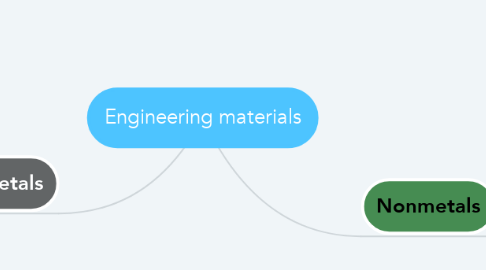
1. Metals
1.1. Ferrous
1.1.1. Cast Iron
1.1.2. Carbon steel
1.1.3. Alloy steel
1.1.4. Stainless steel
1.2. Nonferrous
1.2.1. Aluminium
1.2.2. Copper
1.2.3. Brass
1.2.4. Bronze
1.2.5. Zinc
1.2.6. Magnesium
1.2.7. Titanium
1.2.8. Tin
2. Nonmetals
2.1. Organic
2.1.1. Polymers
2.1.1.1. Thermoplastic
2.1.1.1.1. Polypropylene
2.1.1.1.2. Polyethylene
2.1.1.1.3. Polystyrene
2.1.1.1.4. Vinyl
2.1.1.1.5. ABS
2.1.1.1.6. Acrylic
2.1.1.1.7. Acetal
2.1.1.1.8. Polycarbonate
2.1.1.1.9. Nylon
2.1.1.2. Thermosetting
2.1.1.2.1. Phenolic
2.1.1.2.2. Polyester
2.1.1.2.3. Melamine
2.1.1.2.4. Urethane
2.1.1.2.5. Epoxy
2.1.1.2.6. Alkyd
2.1.1.2.7. Diallyl phthalate
2.1.1.3. Elastomers
2.1.1.3.1. Rubber (natural)
2.1.1.3.2. Butyl
2.1.1.3.3. Silicone
2.1.1.3.4. Fluorocarbon
2.1.1.3.5. Polysulfide
2.1.1.3.6. Neoprene
2.1.1.3.7. Styrene butadiene
2.1.1.3.8. Nitrile
2.1.1.3.9. Polyurethanes
2.1.1.3.10. Thermoplastic elastomers
2.1.2. Others
2.1.2.1. Carbon
2.1.2.2. Wood
2.1.2.3. Fiber
2.1.2.4. Paper
2.1.2.5. Leather
2.2. Inorganic
2.2.1. Ceramic
2.2.1.1. Alumina
2.2.1.2. Magnesia
2.2.1.3. Beryllia
2.2.1.4. Carbide
2.2.1.5. Nitride
2.2.1.6. Stealite
2.2.2. Glass
2.2.2.1. Silica
2.2.2.2. Soda lime
2.2.2.3. Lead
2.2.3. Others
2.2.3.1. Mica
2.2.3.2. Concrete plasters
